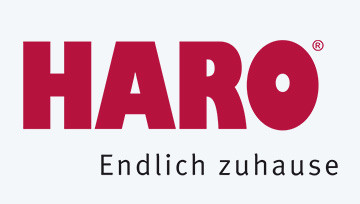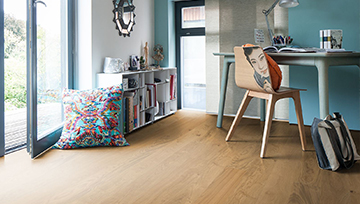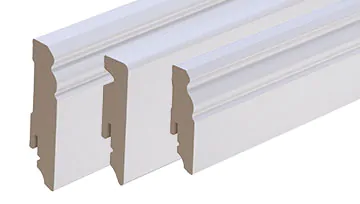HARO Parquet
Haro parquet, more up-to-date than ever
In times of the bio-boom and the grouping of the Lohas (Lifestyles of Health and Sustainability), where sustainable, healthy and conscious living has moved into the general focus, there has been a general return to a near-natural living environment.
Haro parquet floor
Haro parquet is offered both for gluing and with a click connection system for floating installation. Which variant is more suitable for you depends not only on your manual skills, but also on the planned location
Fully glued parquet produces less impact sound. Walking and impact sound is amplified by the air space between the subfloor and the parquet, which serves as a resonance body, when the parquet is laid in a floating manner. This resonance space is missing when glued
Therefore glued parquet is quieter. On the other hand, you can only remove a glued parquet floor with great effort. Parquet laid using the click system, on the other hand, can be easily removed again
Parquet that has an insulating underlay laminated onto it is not suitable for gluing. Information on the type of installation for which the parquet is suitable can be found in the product description of Parkett Kaiser.
Numerous surface finishes increase the choice of design for Haro parquet
Depending on how the surface of a parquet floorboard is processed, it has a completely different visual and haptic effect. With Haro Parquet you have the choice between:
- structured: The parquet is treated with special brushes. This results in the surface structure.
- retro structured: This treatment gives the parquet a used look. The parquet looks as if it has been in use for years.
- retro structured 3D: treatment that gives the parquet not only a used look but also a historical appearance.
- Relief structured: Delivers a particularly natural looking parquet with noticeable ups and downs on the surface.
- scraped: Processing the wood with a plane leads to clearly noticeable ups and downs on the surface.
Haro parquet is environmentally friendly
Haro parquet is marked with the "Blue Angel" as an environmentally friendly, low-emission product. In addition, the PEFC and FEP seals document that the wood for this parquet comes from sustainable forestry. The WKI seal of approval means that this floor covering has been tested for harmful substances according to the guidelines of the "German Institute for Construction Technology"
The ISO1401 certification also attests to environmental quality. By the way, this parquet is made in Germany.
How to prepare the installation of Haro parquet
- Give Haro parquet 48 hours to acclimatize in the room. To do this, lay the unopened packages flat on the floor of the room.
- Are you planning a floating installation of the parquet? Then you have to allow for expansion joints after 10 m length or 10 m width.
- Obtain a sufficient number of spacer wedges from a specialist dealer. You need these to be able to create an even expansion joint on the walls.
- The subfloor on which you want to lay the parquet must be clean, solid, dry and even.
- When laying on screed, the residual moisture must not exceed the following values:
Cementitious and cement-based flowing screed without underfloor heating: 2 % CM
Calcium sulphate and calcium sulphate flow screed without underfloor heating: 0,5 % CM
Cement and cement-based flowing screed with underfloor heating: 1.8 % CM
Calcium sulphate and calcium sulphate flow screed with underfloor heating: 0,3 % CM - When buying the parquet, add 5% to 10% to the calculated amount. You always have waste when laying parquet flooring.
- At the transitions of the parquet floor from one room to another you need transition profiles. These consist of a lower and an upper rail. The bottom rail must be attached before laying the parquet.
How to glue the parquet
You start with the laying in a corner of the room. They must maintain an expansion joint of approx. 2 mm per meter of room width to the walls. Use spacer wedges to make these expansion joints even.
You lay the first three rows (without glue!). Lay out the first row and click them into each other at the top. Start the second row with the rest of the first row. This automatically gives you an offset of approx. 1/3 of the plank length
Push the boards of the second row lengthwise from the top into the boards of the first row and press them down carefully. If you have laid three rows like this, carefully take them apart again.
Now it's time to glue. To do this, apply the adhesive for three rows to the substrate with a spatula. You will then have about 20 minutes before the adhesive sets. Now lay out your prepared three rows on the adhesive bed. Then weigh them down with unopened parquet packages
Proceed with the installation immediately - always prepare three rows and then glue them together, then remove the spacer wedges and fit skirting boards and the top rails of the transition profiles.
How is the parquet laid as a floating floor?
For floating installation, you must install impact sound insulation. The space between the loose parquet and the subfloor acts as a resonance body for impact sound. In addition, you need a vapour barrier for mineral substrates
This is a thin foil that prevents moisture from the subfloor from penetrating into the parquet. Before you start the installation, please read the installation information of the manufacturer!
Start in the corner of a room and lay out the first row so that the elements are connected at the top. To do this, push the second element diagonally from above into the first and then press it down carefully. Probably you will have to cut the last element of the first row to length
Use the remainder of this as the first element of the second row. In this way, you automatically obtain the required offset from row to row. This should be about one third of the length of the board. The elements of the second and all further rows are also pushed lengthwise diagonally from above into the previous element and then pressed down.
Even with this type of installation, you must maintain an expansion joint all around. The last step is to install the skirting boards and the top rails of the transition or compensation profiles.
This is what inspires on Haro parquet flooring
- Due to its favourable thermal properties, the parquet is always warm to the feet.
- Perfect for the living area
- Durable and hard-wearing
- sound-absorbent
- Parquet is hygienic and easy to maintain. This is particularly interesting in view of the constantly growing number of allergy sufferers and for pet owners a really clean thing.
- Parquet is timelessly modern. Especially with the huge selection of different parquet floors, such as those offered by Germany's largest manufacturer of parquet flooring.
Haro and its huge selection of parquet floors
Haro parquet is available in 2-layer and 3-layer versions. The 2-layer variant means that the planks consist of a top layer (wear layer) and a carrier
Which can be laid in the traditional way, glued. Since wood is a natural product, it shrinks or expands depending on the season. These material properties are more pronounced in solid wood floors than in multi-layer parquet.
Multi-layer parquet is the modern type of plank flooring, the three-layer structure consists of a wear layer / carrier plate/ counter layer. Since it only has to be 2.5 millimetres thick, the lower consumption of resources protects the environment and the material "works" much less when exposed to temperature fluctuations
The wear layer is made of high-quality precious wood and can be sanded off in case of defects. Underneath this are the middle layer and possibly a third layer, which consists of coniferous woods and improves stability
This stable multi-layer construction allows the installation of a so-called click connection, the now so popular Klick Parquet, a parquet floor that can be laid fairly easily even by laymen.
With finished parquet, the surface of the parquet is already treated and can be walked on directly, regardless of whether it is multi-layer or solid parquet.
In addition, there are several variants of parquet flooring and wood species that are particularly interesting for their appearance and spatial effect. Like the Haro plank and the Haro ship floor.
Haro country house floorboards
For the Haro plank, the planks are sawn to log length. About 18 centimetres wide and 1.35 centimetres thick planks are used - but there are also other lengths and widths
Elaborate plank floors, such as the Haro country house planks in oak, are connected by a click connection, whereby the planks are laid along the longitudinal axis of the room
Haro Parquet 4000 is available in light and dark oak, walnut and beech in different colours and surface treatments.
Haro 4000 ship floor
With this classic pattern of parquet flooring one is involuntarily reminded of ship planks, which are suitable for almost any room
Haro ship's floors generally convey a sense of calm and make a room look longer. Haro ship floors are also available in many types and colours in parquet oak. In addition to oak parquet flooring, there are other interesting wood species on offer, including maple.




